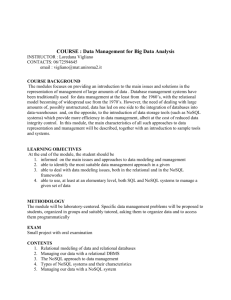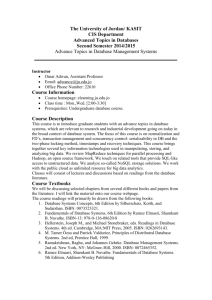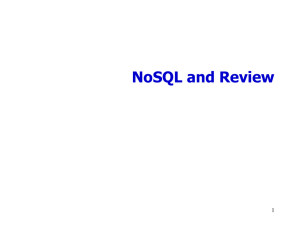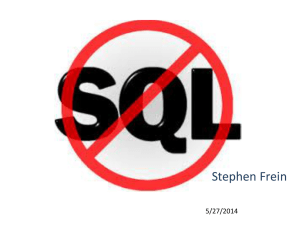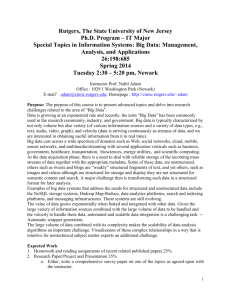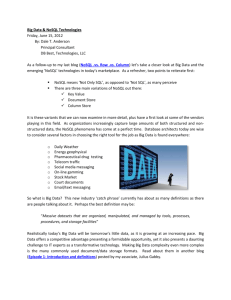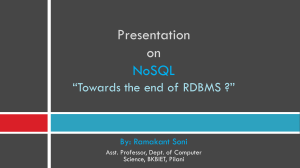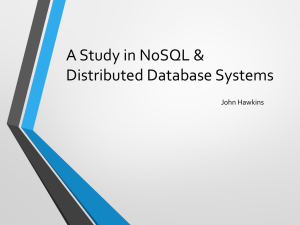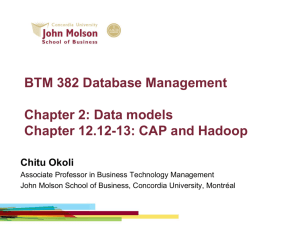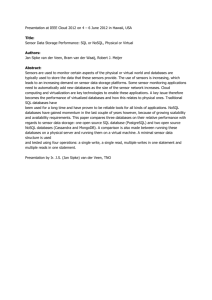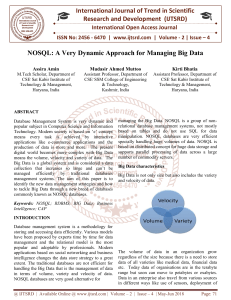A Study on NoSQL technologies handling Big Data
advertisement
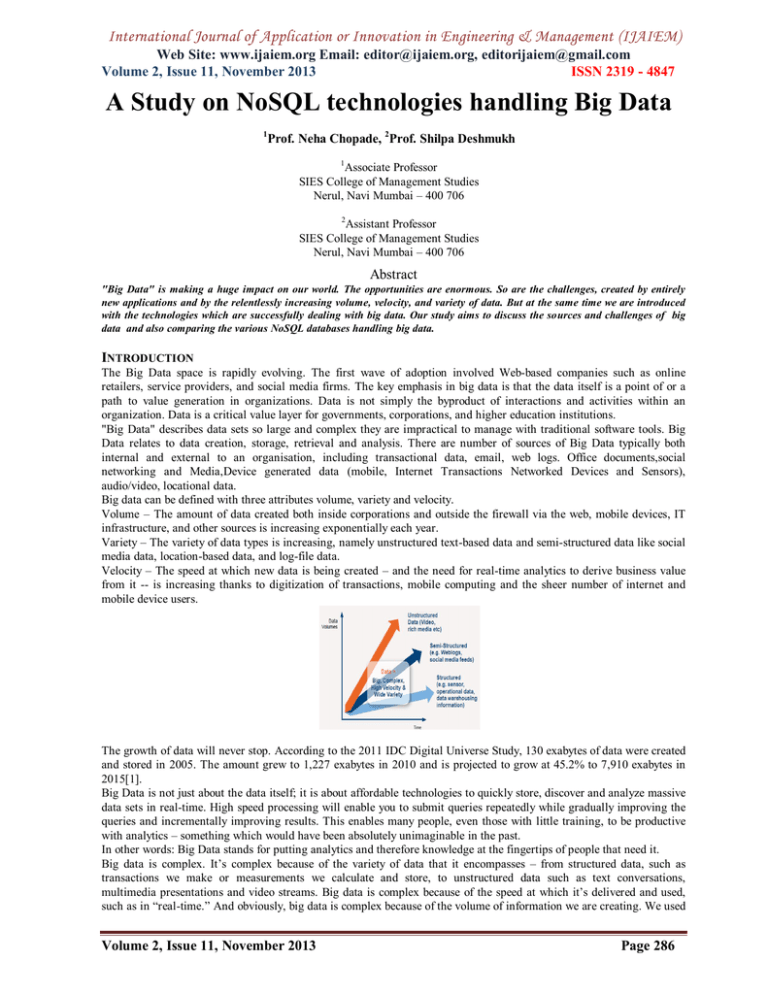
International Journal of Application or Innovation in Engineering & Management (IJAIEM) Web Site: www.ijaiem.org Email: editor@ijaiem.org, editorijaiem@gmail.com Volume 2, Issue 11, November 2013 ISSN 2319 - 4847 A Study on NoSQL technologies handling Big Data 1 Prof. Neha Chopade, 2Prof. Shilpa Deshmukh 1 Associate Professor SIES College of Management Studies Nerul, Navi Mumbai – 400 706 2 Assistant Professor SIES College of Management Studies Nerul, Navi Mumbai – 400 706 Abstract "Big Data" is making a huge impact on our world. The opportunities are enormous. So are the challenges, created by entirely new applications and by the relentlessly increasing volume, velocity, and variety of data. But at the same time we are introduced with the technologies which are successfully dealing with big data. Our study aims to discuss the sources and challenges of big data and also comparing the various NoSQL databases handling big data. INTRODUCTION The Big Data space is rapidly evolving. The first wave of adoption involved Web-based companies such as online retailers, service providers, and social media firms. The key emphasis in big data is that the data itself is a point of or a path to value generation in organizations. Data is not simply the byproduct of interactions and activities within an organization. Data is a critical value layer for governments, corporations, and higher education institutions. "Big Data" describes data sets so large and complex they are impractical to manage with traditional software tools. Big Data relates to data creation, storage, retrieval and analysis. There are number of sources of Big Data typically both internal and external to an organisation, including transactional data, email, web logs. Office documents,social networking and Media,Device generated data (mobile, Internet Transactions Networked Devices and Sensors), audio/video, locational data. Big data can be defined with three attributes volume, variety and velocity. Volume – The amount of data created both inside corporations and outside the firewall via the web, mobile devices, IT infrastructure, and other sources is increasing exponentially each year. Variety – The variety of data types is increasing, namely unstructured text-based data and semi-structured data like social media data, location-based data, and log-file data. Velocity – The speed at which new data is being created – and the need for real-time analytics to derive business value from it -- is increasing thanks to digitization of transactions, mobile computing and the sheer number of internet and mobile device users. The growth of data will never stop. According to the 2011 IDC Digital Universe Study, 130 exabytes of data were created and stored in 2005. The amount grew to 1,227 exabytes in 2010 and is projected to grow at 45.2% to 7,910 exabytes in 2015[1]. Big Data is not just about the data itself; it is about affordable technologies to quickly store, discover and analyze massive data sets in real-time. High speed processing will enable you to submit queries repeatedly while gradually improving the queries and incrementally improving results. This enables many people, even those with little training, to be productive with analytics – something which would have been absolutely unimaginable in the past. In other words: Big Data stands for putting analytics and therefore knowledge at the fingertips of people that need it. Big data is complex. It’s complex because of the variety of data that it encompasses – from structured data, such as transactions we make or measurements we calculate and store, to unstructured data such as text conversations, multimedia presentations and video streams. Big data is complex because of the speed at which it’s delivered and used, such as in “real-time.” And obviously, big data is complex because of the volume of information we are creating. We used Volume 2, Issue 11, November 2013 Page 286 International Journal of Application or Innovation in Engineering & Management (IJAIEM) Web Site: www.ijaiem.org Email: editor@ijaiem.org, editorijaiem@gmail.com Volume 2, Issue 11, November 2013 ISSN 2319 - 4847 to speak in terms of megabytes and gigabytes of home storage – now we speak in terms of terabytes. Enterprises speak in terms of petabytes[2]. SOURCES OF BIG DATA 1. Social network profiles—Tapping user profiles from Facebook, LinkedIn, Yahoo, Google, and specific-interest social or travel sites, to cull individuals’ profiles and demographic information, and extend that to capture their hopefully-likeminded networks. (This requires a fairly straightforward API integration for importing pre-defined fields and values – for example, a social network API integration that gathers every B2B marketer on Twitter.) 2. Social influencers—Editor, analyst and subject-matter expert blog comments, user forums, Twitter & Facebook “likes,” Yelp-style catalog and review sites, and other review-centric sites like Apple’s App Store, Amazon, ZDNet, etc. (Accessing this data requires Natural Language Processing and/or text-based search capability to evaluate the positive/negative nature of words and phrases, derive meaning, index, and write the results). 3. Activity-generated data—Computer and mobile device log files, aka “The Internet of Things.” This category includes web site tracking information, application logs, and sensor data – such as check-ins and other location tracking – among other machine-generated content. But consider also the data generated by the processors found within vehicles, video games, cable boxes or, soon, household appliances. (Parsing technologies such as those from Splunk or Xenos help make sense of these types of semi-structured text files and documents.) 4. Software as a Service (SaaS) and cloud applications—Systems like Salesforce.com, Netsuite, SuccessFactors, etc. all represent data that’s already in the Cloud but is difficult to move and merge with internal data. (Distributed data integration technology, in-memory caching technology and API integration work may be appropriate here.) 5. Public—Microsoft Azure MarketPlace/DataMarket, The World Bank, SEC/Edgar, Wikipedia, IMDb, etc. – data that is publicly available on the Web which may enhance the types of analysis able to be performed. (Use the same types of parsing, usage, search and categorization techniques as for the three previously mentioned sources.) 6. Hadoop MapReduce application results—The next generation technology architectures for handling and parallel parsing of data from logs, Web posts, etc., promise to create a new generations of pre- and post-processed data. We foresee a ton of new products that will address application use cases for any kinds of Big Data – just look at the partner lists of Cloudera and Hortonworks. In fact, we won’t be surprised if layers of MapReduce applications blending everything mentioned above (consolidating, “reducing” and aggregating Big Data in a layered or hierarchical approach) are very likely to become their own “Big Data”. 7. Data warehouse appliances—Teradata, IBM Netezza, EMC Greenplum, etc. are collecting from operational systems the internal, transactional data that is already prepared for analysis. These will likely become an integration target that will assist in enhancing the parsed and reduced results from your Big Data installation. 8. Columnar/NoSQL data sources—MongoDB, Cassandra, InfoBright, etc. – examples of a new type of map reduce repository and data aggregator. These are specialty applications that fill gaps in Hadoop-based environments, for example Cassandra’s use in collecting large volumes of real-time, distributed data. 9. Network and in-stream monitoring technologies—Packet evaluation and distributed query processing-like applications as well as email parsers are also likely areas that will explode with new startup technologies. 10. Legacy documents—Archives of statements, insurance forms, medical record and customer correspondence are still an untapped resource. (Many archives are full of old PDF documents and print streams files that contain original and only systems of record between organizations and their customers. Parsing this semi-structured legacy content can be challenging without specialty tools like Xenos.) [3]. Other Weather Intelligence/defense data Search log Web logs Other log files Network … Application logs 4% 5% 5% 13% 13% 16% 19% 21% 29% 31% 34% 34% 36% 36% 47% Customer/member data 60% 65% Figure1 sources of big data figure Volume 2, Issue 11, November 2013 Page 287 International Journal of Application or Innovation in Engineering & Management (IJAIEM) Web Site: www.ijaiem.org Email: editor@ijaiem.org, editorijaiem@gmail.com Volume 2, Issue 11, November 2013 ISSN 2319 - 4847 CHALLENGES Many organizations are concerned that the amount of amassed data is becoming so large that it is difficult to find the most valuable pieces of information. What if your data volume gets so large and varied you don't know how to deal with it? Do you store all your data? Do you analyze it all? How can you find out which data points are really important? How can you use it to your best advantage? Until recently, organizations have been limited to using subsets of their data, or they were constrained to simplistic analyses because the sheer volumes of data overwhelmed their processing platforms. But, what is the point of collecting and storing terabytes of data if you can't analyze it in full context, or if you have to wait hours or days to get results? On the other hand, not all business questions are better answered by bigger data. You now have two choices: Incorporate massive data volumes in analysis. If the answers you're seeking will be better provided by analyzing all of your data, go for it. High-performance technologies that extract value from massive amounts of data are here today. One approach is to apply high-performance analytics to analyze the massive amounts of data using technologies such as grid computing, in-database processing and in-memory analytics. Determine upfront which data is relevant. Traditionally, the trend has been to store everything (some call it data hoarding) and only when you query the data do you discover what is relevant. We now have the ability to apply analytics on the front end to determine relevance based on context. This type of analysis determines which data should be included in analytical processes and what can be placed in low-cost storage for later use if needed. Big data presents a number of challenges relating to its complexity. One challenge is how we can understand and use big data when it comes in an unstructured format, such as text or video. Another challenge is how we can capture the most important data as it happens and deliver that to the right people in real-time. A third challenge is how we can store the data, and how we can analyze and understand it given its size and our computational capacity. And there are numerous other challenges, from privacy and security to access and deployment[4]. The real issue is not that you are acquiring large amounts of data. It's what you do with the data that counts. The hopeful vision is that organizations will be able to take data from any source, harness relevant data and analyze it to find answers that enable 1) cost reductions, 2) time reductions, 3) new product development and optimized offerings, and 4) smarter business decision making. For instance, by combining big data and high-powered analytics, it is possible to: Determine root causes of failures, issues and defects in near-real time, potentially saving billions of dollars annually.Optimize routes for many thousands of package delivery vehicles while they are on the road.Analyze millions of SKUs to determine prices that maximize profit and clear inventory.Generate retail coupons at the point of sale based on the customer's current and past purchases.Send tailored recommendations to mobile devices while customers are in the right area to take advantage of offers.Recalculate entire risk portfolios in minutes. Quickly identify customers who matter the cost. Use clickstream analysis and data mining to detect fraudulent behavior[5]. NOSQL DATABASES TO DEAL WITH BIG DATA Big Data is creating new opportunities for organizations to serve customers and markets — while also creating and extracting value — in new ways. There are several technologies to handle big data such as MapReduce, Hadoop, NoSQL, PIG and Hive. In this paper we are focusing on the various NOSQL tools. NoSQL database provides the foundation for many of these systems, not only as a real-time, operational data store but in offline capacities as well. Traditionally, the work of capturing and analyzing data has required different technologies, different infrastructure and redundant costs. It is often used for storing Big Data. This is a new type of database which is becoming more and more popular among web companies today. Proponents of NoSQL solutions state that they provide simpler scalability and improved performance relative to traditional relational databases. These products excel at storing “unstructured data,” and the category includes open source products such as MongoDB, and Redis. NoSQL encompasses a wide variety of different database technologies and were developed in response to a rise in the volume of data stored about users, objects and products, the frequency in which this data is accessed, and performance and processing needs[6]. The comparative study done on NoSQL tools for the period 2009 to 2012 is presented in a summarized form in table1 which is as follows: Volume 2, Issue 11, November 2013 Page 288 International Journal of Application or Innovation in Engineering & Management (IJAIEM) Web Site: www.ijaiem.org Email: editor@ijaiem.org, editorijaiem@gmail.com Volume 2, Issue 11, November 2013 ISSN 2319 - 4847 Table1 : Comparision of NoSQL Databases CONCLUSION We can conclude that NoSQL databases are efficiently handling the challenges of big data.We have studied and compared the various NoSQL databases introduced from year 2009 to 2012. Most of the databases discussed here are open source. Many recent NoSQL databases are supported by various operating systems. But these databases are not necessarily fully satisfying the ACID properties and CAP theorem. REFERENCES [1] IDC. The 2011 Digital Universe Study: Extracting Value from Chaos. [Online] Available from: http://www.emc.com/collateral/analyst-reports/idc-extracting-value-from-chaos-ar.pdf [Accessed 24th Sept 2013]. [2] http://spotfire.tibco.com/blog/?p=6793 [Accessed 3rd Oct 2013] [3] http://www.zdnet.com/top-10-categories-for-big-data-sources-and-mining-technologies-7000000926/ [Accessed 10th Oct 2013] [4] http://spotfire.tibco.com/blog/?p=6793 [Accessed 19th Oct 2013] [5] http://www.sas.com/big-data/ [Accessed 3rd Oct 2013] [6] http://www.mongodb.com/learn/nosql[Accessed 5th Oct 2013] AUTHOR Neha Chopade received the M.C.A degree from Govt. Geetanjali Girls College, Bhopal in the year 2000. Area of interest for research in Database Management System,Data Minning & Advanced Database Technologies. Having 13 years of teaching experience. Shilpa Deshmukh received the M.C.A degree from Amravati University in the year 2002. Area of interest for research in Database Management System & Web Mining. Having 10 years of teaching experience. Volume 2, Issue 11, November 2013 Page 289
